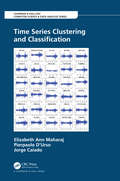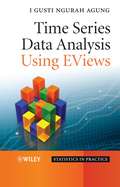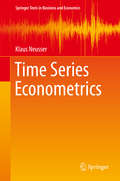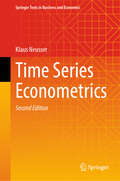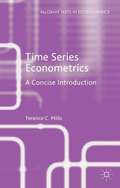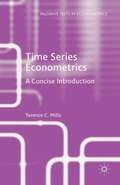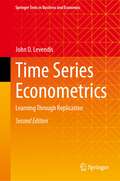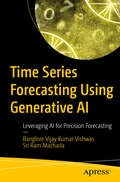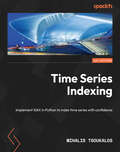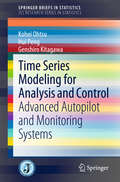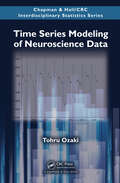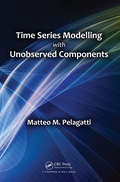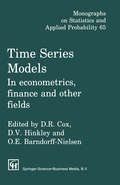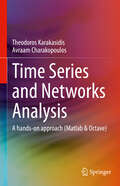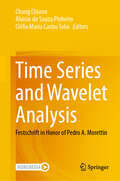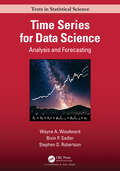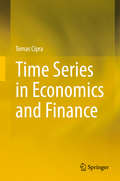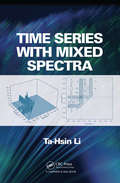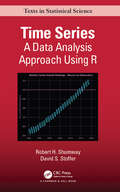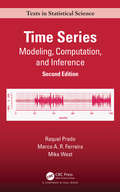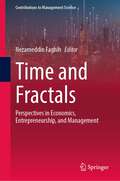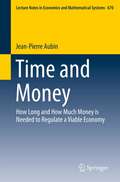- Table View
- List View
Time Series Clustering and Classification (Chapman & Hall/CRC Computer Science & Data Analysis)
by Elizabeth Ann Maharaj Pierpaolo D'Urso Jorge CaiadoThe beginning of the age of artificial intelligence and machine learning has created new challenges and opportunities for data analysts, statisticians, mathematicians, econometricians, computer scientists and many others. At the root of these techniques are algorithms and methods for clustering and classifying different types of large datasets, including time series data. Time Series Clustering and Classification includes relevant developments on observation-based, feature-based and model-based traditional and fuzzy clustering methods, feature-based and model-based classification methods, and machine learning methods. It presents a broad and self-contained overview of techniques for both researchers and students. Features Provides an overview of the methods and applications of pattern recognition of time series Covers a wide range of techniques, including unsupervised and supervised approaches Includes a range of real examples from medicine, finance, environmental science, and more R and MATLAB code, and relevant data sets are available on a supplementary website
Time Series Data Analysis Using EViews: Forecasting Using Eviews
by I. Gusti AgungDo you want to recognize the most suitable models for analysis of statistical data sets? This book provides a hands-on practical guide to using the most suitable models for analysis of statistical data sets using EViews - an interactive Windows-based computer software program for sophisticated data analysis, regression, and forecasting - to define and test statistical hypotheses. Rich in examples and with an emphasis on how to develop acceptable statistical models, Time Series Data Analysis Using EViews is a perfect complement to theoretical books presenting statistical or econometric models for time series data. The procedures introduced are easily extendible to cross-section data sets. The author: Provides step-by-step directions on how to apply EViews software to time series data analysis Offers guidance on how to develop and evaluate alternative empirical models, permitting the most appropriate to be selected without the need for computational formulae Examines a variety of times series models, including continuous growth, discontinuous growth, seemingly causal, regression, ARCH, and GARCH as well as a general form of nonlinear time series and nonparametric models Gives over 250 illustrative examples and notes based on the author's own empirical findings, allowing the advantages and limitations of each model to be understood Describes the theory behind the models in comprehensive appendices Provides supplementary information and data sets An essential tool for advanced undergraduate and graduate students taking finance or econometrics courses. Statistics, life sciences, and social science students, as well as applied researchers, will also find this book an invaluable resource.
Time Series Econometrics
by Klaus NeusserThis text presents modern developments in time series analysis and focuses on their application to economic problems. The book first introduces the fundamental concept of a stationary time series and the basic properties of covariance, investigating the structure and estimation of autoregressive-moving average (ARMA) models and their relations to the covariance structure. The book then moves on to non-stationary time series, highlighting its consequences for modeling and forecasting and presenting standard statistical tests and regressions. Next, the text discusses volatility models and their applications in the analysis of financial market data, focusing on generalized autoregressive conditional heteroskedastic (GARCH) models. The second part of the text devoted to multivariate processes, such as vector autoregressive (VAR) models and structural vector autoregressive (SVAR) models, which have become the main tools in empirical macroeconomics. The text concludes with a discussion of co-integrated models and the Kalman Filter, which is being used with increasing frequency. Mathematically rigorous, yet application-oriented, this self-contained text will help students develop a deeper understanding of theory and better command of the models that are vital to the field. Assuming a basic knowledge of statistics and/or econometrics, this text is best suited for advanced undergraduate and beginning graduate students.
Time Series Econometrics (Springer Texts in Business and Economics)
by Klaus NeusserThis text presents modern developments in time series analysis and focuses on their application to economic problems. The book first introduces the fundamental concept of a stationary time series and its relation to the basic properties of covariance funtions, investigating the structure and estimation of autoregressive-moving average (ARMA) models and their relations to the covariance structure. The book then moves on to non-stationary time series, highlighting its consequences for modeling and forecasting as well as regressions models and presenting standard statistical tests. Next, the text discusses volatility models and their applications in the analysis of financial market data, focusing on generalized autoregressive conditional heteroskedastic (GARCH) models. The second part of the text is devoted to multivariate processes, such as vector autoregressive (VAR) models and structural vector autoregressive (SVAR) models, which have become the main tools in empirical macroeconomics. The text concludes with a discussion of co-integrated models and the Kalman Filter, which is being used with increasing frequency. The exposition finally connects to recent developments in the field. Mathematically rigorous, yet application-oriented, this self-contained text will help students develop a deeper understanding of theory and better command of the models that are vital to the field. Assuming a basic knowledge of statistics and/or econometrics, this text is best suited for advanced undergraduate and beginning graduate students.
Time Series Econometrics: A Concise Introduction (Critical Concepts In Economics)
by Terence C. MillsTime Series Econometrics.
Time Series Econometrics: A Concise Introduction (Palgrave Texts in Econometrics)
by Terence C. MillsThis book provides an introductory treatment of time series econometrics, a subject that is of key importance to both students and practitioners of economics. It contains material that any serious student of economics and finance should be acquainted with if they are seeking to gain an understanding of a real functioning economy.
Time Series Econometrics: Learning Through Replication (Springer Texts in Business and Economics)
by John D. LevendisRevised and updated for the second edition, this textbook allows students to work through classic texts in economics and finance, using the original data and replicating their results. In this book, the author rejects the theorem-proof approach as much as possible, and emphasizes the practical application of econometrics. They show with examples how to calculate and interpret the numerical results.This book begins with students estimating simple univariate models, in a step by step fashion, using the popular Stata software system. Students then test for stationarity, while replicating the actual results from hugely influential papers such as those by Granger & Newbold, and Nelson & Plosser. Readers will learn about structural breaks by replicating papers by Perron, and Zivot & Andrews. They then turn to models of conditional volatility, replicating papers by Bollerslev. Students estimate multi-equation models such as vector autoregressions and vector error-correction mechanisms, replicating the results in influential papers by Sims and Granger. Finally, students estimate static and dynamic panel data models, replicating papers by Thompson, and Arellano & Bond.The book contains many worked-out examples, and many data-driven exercises. While intended primarily for graduate students and advanced undergraduates, practitioners will also find the book useful.“How to best start learning time series econometrics? Learning by doing. This is the ethos of this book. What makes this book useful is that it provides numerous worked out examples along with basic concepts. It is a fresh, no-nonsense, practical approach that students will love when they start learning time series econometrics. I recommend this book strongly as a study guide for students who look for hands-on learning experience."--Professor Sokbae "Simon" Lee, Columbia University, Co-Editor of Econometric Theory and Associate Editor of Econometrics Journal.
Time Series Forecasting Using Generative AI: Leveraging AI for Precision Forecasting
by Banglore Vijay Vishwas Sri Ram Macharla"Time Series Forecasting Using Generative AI introduces readers to Generative Artificial Intelligence (Gen AI) in time series analysis, offering an essential exploration of cutting-edge forecasting methodologies." The book covers a wide range of topics, starting with an overview of Generative AI, where readers gain insights into the history and fundamentals of Gen AI with a brief introduction to large language models. The subsequent chapter explains practical applications, guiding readers through the implementation of diverse neural network architectures for time series analysis such as Multi-Layer Perceptrons (MLP), WaveNet, Temporal Convolutional Network (TCN), Bidirectional Temporal Convolutional Network (BiTCN), Recurrent Neural Networks (RNN), Long Short-Term Memory (LSTM), Deep AutoRegressive(DeepAR), and Neural Basis Expansion Analysis(NBEATS) using modern tools. Building on this foundation, the book introduces the power of Transformer architecture, exploring its variants such as Vanilla Transformers, Inverted Transformer (iTransformer), DLinear, NLinear, and Patch Time Series Transformer (PatchTST). Finally, The book delves into foundation models such as Time-LLM, Chronos, TimeGPT, Moirai, and TimesFM enabling readers to implement sophisticated forecasting models tailored to their specific needs. This book empowers readers with the knowledge and skills needed to leverage Gen AI for accurate and efficient time series forecasting. By providing a detailed exploration of advanced forecasting models and methodologies, this book enables practitioners to make informed decisions and drive business growth through data-driven insights. ● Understand the core history and applications of Gen AI and its potential to revolutionize time series forecasting. ● Learn to implement different neural network architectures such as MLP, WaveNet, TCN, BiTCN, RNN, LSTM, DeepAR, and NBEATS for time series forecasting. ● Discover the potential of Transformer architecture and its variants, such as Vanilla Transformers, iTransformer, DLinear, NLinear, and PatchTST, for time series forecasting. <span sty
Time Series Indexing: Implement iSAX in Python to index time series with confidence
by Mihalis TsoukalosBuild and use the most popular time series index available today with Python to search and join time series at the subsequence level Purchase of the print or Kindle book includes a free PDF eBook.Key FeaturesLearn how to implement algorithms and techniques from research papersGet to grips with building time series indexes using iSAXLeverage iSAX to solve real-world time series problemsBook DescriptionTime series are everywhere, ranging from financial data and system metrics to weather stations and medical records. Being able to access, search, and compare time series data quickly is essential, and this comprehensive guide enables you to do just that by helping you explore SAX representation and the most effective time series index, iSAX. The book begins by teaching you about the implementation of SAX representation in Python as well as the iSAX index, along with the required theory sourced from academic research papers. The chapters are filled with figures and plots to help you follow the presented topics and understand key concepts easily. But what makes this book really great is that it contains the right amount of knowledge about time series indexing using the right amount of theory and practice so that you can work with time series and develop time series indexes successfully. Additionally, the presented code can be easily ported to any other modern programming language, such as Swift, Java, C, C++, Ruby, Kotlin, Go, Rust, and JavaScript. By the end of this book, you'll have learned how to harness the power of iSAX and SAX representation to efficiently index and analyze time series data and will be equipped to develop your own time series indexes and effectively work with time series data.What you will learnFind out how to develop your own Python packages and write simple Python testsUnderstand what a time series index is and why it is usefulGain a theoretical and practical understanding of operating and creating time series indexesDiscover how to use SAX representation and the iSAX indexFind out how to search and compare time seriesUtilize iSAX visualizations to aid in the interpretation of complex or large time seriesWho this book is forThis book is for practitioners, university students working with time series, researchers, and anyone looking to learn more about time series. Basic knowledge of UNIX, Linux, and Python and an understanding of basic programming concepts are needed to grasp the topics in this book. This book will also be handy for people who want to learn how to read research papers, learn from them, and implement their algorithms.
Time Series Modeling for Analysis and Control
by Genshiro Kitagawa Kohei Ohtsu Hui PengThis book presents multivariate time series methods for the analysis and optimal control of feedback systems. Although ships' autopilot systems are considered through the entire book, the methods set forth in this book can be applied to many other complicated, large, or noisy feedback control systems for which it is difficult to derive a model of the entire system based on theory in that subject area. The basic models used in this method are the multivariate autoregressive model with exogenous variables (ARX) model and the radial bases function net-type coefficients ARX model. The noise contribution analysis can then be performed through the estimated autoregressive (AR) model and various types of autopilot systems can be designed through the state-space representation of the models. The marine autopilot systems addressed in this book include optimal controllers for course-keeping motion, rolling reduction controllers with rudder motion, engine governor controllers, noise adaptive autopilots, route-tracking controllers by direct steering, and the reference course-setting approach. The methods presented here are exemplified with real data analysis and experiments on real ships. This book is highly recommended to readers who are interested in designing optimal or adaptive controllers not only of ships but also of any other complicated systems under noisy disturbance conditions.
Time Series Modeling of Neuroscience Data (Chapman & Hall/CRC Interdisciplinary Statistics)
by Tohru OzakiRecent advances in brain science measurement technology have given researchers access to very large-scale time series data such as EEG/MEG data (20 to 100 dimensional) and fMRI (140,000 dimensional) data. To analyze such massive data, efficient computational and statistical methods are required.Time Series Modeling of Neuroscience Data shows how to
Time Series Modelling with Unobserved Components
by Matteo M. PelagattiDespite the unobserved components model (UCM) having many advantages over more popular forecasting techniques based on regression analysis, exponential smoothing, and ARIMA, the UCM is not well known among practitioners outside the academic community. Time Series Modelling with Unobserved Components rectifies this deficiency by giving a practical o
Time Series Models
by Philip Hans FransesThis book considers periodic time series models for seasonal data, characterized by parameters that differ across the seasons, and focuses on their usefulness for out-of-sample forecasting. Providing an up-to-date survey of the recent developments in periodic time series, the book presents a large number of empirical results. The first part of the book deals with model selection, diagnostic checking and forecasting of univariate periodic autoregressive models. Tests for periodic integration, are discussed, and an extensive discussion of the role of deterministic regressors in testing for periodic integration and in forecasting is provided. The second part discusses multivariate periodic autoregressive models. It provides an overview of periodic cointegration models, as these are the most relevant. This overview contains single-equation type tests and a full-system approach based on generalized method of moments. All methods are illustrated with extensive examples, andthe book will be of interest to advanced graduate students and researchers in econometrics, as well as practitioners looking for an understanding of how to approach seasonal data.
Time Series Models: In econometrics, finance and other fields (Chapman And Hall/crc Monographs On Statistics And Applied Probability Ser. #65)
by D.R.Cox; D.V. Hinkley; O.E. Barndorff-NielsenThe analysis prediction and interpolation of economic and other time series has a long history and many applications. Major new developments are taking place, driven partly by the need to analyze financial data. The five papers in this book describe those new developments from various viewpoints and are intended to be an introduction accessible to readers from a range of backgrounds.The book arises out of the second Seminaire European de Statistique (SEMSTAT) held in Oxford in December 1994. This brought together young statisticians from across Europe, and a series of introductory lectures were given on topics at the forefront of current research activity. The lectures form the basis for the five papers contained in the book.The papers by Shephard and Johansen deal respectively with time series models for volatility, i.e. variance heterogeneity, and with cointegration. Clements and Hendry analyze the nature of prediction errors. A complementary review paper by Laird gives a biometrical view of the analysis of short time series. Finally Astrup and Nielsen give a mathematical introduction to the study of option pricing. Whilst the book draws its primary motivation from financial series and from multivariate econometric modelling, the applications are potentially much broader.
Time Series and Networks Analysis: A hands-on approach (Matlab & Octave)
by Theodoros Karakasidis Avraam CharakopoulosThis textbook provides students with a hands-on introduction to time series analysis. Readers will learn the potential of the methods but also benefit from a step-by-step guide to apply them on simple data, as well as applications in real science in domains such as physics, environmental science, physics of fluids, simulation analysis etc. The authors emphasize application of the techniques and modern methodologies for time series analysis, using examples to demonstrate techniques introduced, including detailed, step-by-step solutions. Octave and Matlab are used as the computational environment for the applications, since the readers can find programs easily for many applications. The commands are clearly explained and the files are provided in the text and online.
Time Series and Wavelet Analysis: Festschrift in Honor of Pedro A. Morettin
by Chang Chiann Aluisio de Souza Pinheiro Clélia Maria Castro ToloiProf. Pedro A. Morettin is a Distinguished Professor of Statistics at the Institute of Mathematics and Statistics of the University of São Paulo (IME-USP), where he has built an academic career spanning almost six decades. His work has had a significant impact on Time Series Analysis and Wavelet Statistical Methods, as exemplified by the papers appearing in this Festschrift, which are authored by renowned researchers in both fields. Besides his long-term commitment to research, Prof. Morettin is very active in mentoring and serving the profession. Moreover, he has written several textbooks, which are still a leading source of knowledge and learning for undergraduate and graduate students, practitioners, and researchers. Divided into two parts, the Festschrift presents a collection of papers that illustrate Prof. Morettin’s broad contributions to Time Series and Econometrics, and to Wavelets. The reader will be able to learn state-of-the-art statistical methodologies, from periodic ARMA models, fractional Brownian motion, and generalized Ornstein-Uhlenbeck processes to spatial models, passing through complex structures designed for high-dimensional data analysis, such as graph and dynamic models. The topics and data features discussed here include high-frequency sampling, fNRIS, forecasting, portfolio apportionment, volatility assessment, dairy production, and inflation, which are relevant to econometrics, medicine, and the food industry. The volume ends with a discussion of several very powerful tools based on wavelets, spectral analysis, dimensionality reduction, self-similarity, scaling, copulas, and other notions.
Time Series for Data Science: Analysis and Forecasting (Chapman & Hall/CRC Texts in Statistical Science)
by Wayne A. Woodward Stephen Robertson Bivin Philip SadlerData Science students and practitioners want to find a forecast that “works” and don’t want to be constrained to a single forecasting strategy, Time Series for Data Science: Analysis and Forecasting discusses techniques of ensemble modelling for combining information from several strategies. Covering time series regression models, exponential smoothing, Holt-Winters forecasting, and Neural Networks. It places a particular emphasis on classical ARMA and ARIMA models that is often lacking from other textbooks on the subject.This book is an accessible guide that doesn’t require a background in calculus to be engaging but does not shy away from deeper explanations of the techniques discussed.Features: Provides a thorough coverage and comparison of a wide array of time series models and methods: Exponential Smoothing, Holt Winters, ARMA and ARIMA, deep learning models including RNNs, LSTMs, GRUs, and ensemble models composed of combinations of these models. Introduces the factor table representation of ARMA and ARIMA models. This representation is not available in any other book at this level and is extremely useful in both practice and pedagogy. Uses real world examples that can be readily found via web links from sources such as the US Bureau of Statistics, Department of Transportation and the World Bank. There is an accompanying R package that is easy to use and requires little or no previous R experience. The package implements the wide variety of models and methods presented in the book and has tremendous pedagogical use.
Time Series in Economics and Finance
by Tomas CipraThis book presents the principles and methods for the practical analysis and prediction of economic and financial time series. It covers decomposition methods, autocorrelation methods for univariate time series, volatility and duration modeling for financial time series, and multivariate time series methods, such as cointegration and recursive state space modeling. It also includes numerous practical examples to demonstrate the theory using real-world data, as well as exercises at the end of each chapter to aid understanding. This book serves as a reference text for researchers, students and practitioners interested in time series, and can also be used for university courses on econometrics or computational finance.
Time Series with Mixed Spectra
by Ta-Hsin LiTime series with mixed spectra are characterized by hidden periodic components buried in random noise. Despite strong interest in the statistical and signal processing communities, no book offers a comprehensive and up-to-date treatment of the subject. Filling this void, Time Series with Mixed Spectra focuses on the methods and theory for the stati
Time Series: A Data Analysis Approach Using R (Chapman & Hall/CRC Texts in Statistical Science)
by Robert Shumway David StofferThe goals of this text are to develop the skills and an appreciation for the richness and versatility of modern time series analysis as a tool for analyzing dependent data. A useful feature of the presentation is the inclusion of nontrivial data sets illustrating the richness of potential applications to problems in the biological, physical, and social sciences as well as medicine. The text presents a balanced and comprehensive treatment of both time and frequency domain methods with an emphasis on data analysis. Numerous examples using data illustrate solutions to problems such as discovering natural and anthropogenic climate change, evaluating pain perception experiments using functional magnetic resonance imaging, and the analysis of economic and financial problems. The text can be used for a one semester/quarter introductory time series course where the prerequisites are an understanding of linear regression, basic calculus-based probability skills, and math skills at the high school level. All of the numerical examples use the R statistical package without assuming that the reader has previously used the software. Robert H. Shumway is Professor Emeritus of Statistics, University of California, Davis. He is a Fellow of the American Statistical Association and has won the American Statistical Association Award for Outstanding Statistical Application. He is the author of numerous texts and served on editorial boards such as the Journal of Forecasting and the Journal of the American Statistical Association. David S. Stoffer is Professor of Statistics, University of Pittsburgh. He is a Fellow of the American Statistical Association and has won the American Statistical Association Award for Outstanding Statistical Application. He is currently on the editorial boards of the Journal of Forecasting, the Annals of Statistical Mathematics, and the Journal of Time Series Analysis. He served as a Program Director in the Division of Mathematical Sciences at the National Science Foundation and as an Associate Editor for the Journal of the American Statistical Association and the Journal of Business & Economic Statistics.
Time Series: A First Course with Bootstrap Starter
by Dimitris Politis Tucker McElroyTime Series: A First Course with Bootstrap Starter provides an introductory course on time series analysis that satisfies the triptych of (i) mathematical completeness, (ii) computational illustration and implementation, and (iii) conciseness and accessibility to upper-level undergraduate and M.S. students. Basic theoretical results are presented in a mathematically convincing way, and the methods of data analysis are developed through examples and exercises parsed in R. A student with a basic course in mathematical statistics will learn both how to analyze time series and how to interpret the results. <p><p>The book provides the foundation of time series methods, including linear filters and a geometric approach to prediction. The important paradigm of ARMA models is studied in-depth, as well as frequency domain methods. Entropy and other information theoretic notions are introduced, with applications to time series modeling. The second half of the book focuses on statistical inference, the fitting of time series models, as well as computational facets of forecasting. <p><p>Many time series of interest are nonlinear in which case classical inference methods can fail, but bootstrap methods may come to the rescue. Distinctive features of the book are the emphasis on geometric notions and the frequency domain, the discussion of entropy maximization, and a thorough treatment of recent computer-intensive methods for time series such as subsampling and the bootstrap. There are more than 600 exercises, half of which involve R coding and/or data analysis. Supplements include a website with 12 key data sets and all R code for the book's examples, as well as the solutions to exercises.
Time Series: Modeling, Computation, and Inference, Second Edition (Chapman & Hall/CRC Texts in Statistical Science)
by Mike West Raquel Prado Marco A. FerreiraFocusing on Bayesian approaches and computations using analytic and simulation-based methods for inference, Time Series: Modeling, Computation, and Inference, Second Edition integrates mainstream approaches for time series modeling with significant recent developments in methodology and applications of time series analysis. It encompasses a graduate-level account of Bayesian time series modeling, analysis and forecasting, a broad range of references to state-of-the-art approaches to univariate and multivariate time series analysis, and contacts research frontiers in multivariate time series modeling and forecasting. It presents overviews of several classes of models and related methodology for inference, statistical computation for model fitting and assessment, and forecasting. It explores the connections between time- and frequency-domain approaches and develop various models and analyses using Bayesian formulations and computation, including use of computations based on Markov chain Monte Carlo (MCMC) and sequential Monte Carlo (SMC) methods. It illustrates the models and methods with examples and case studies from a variety of fields, including signal processing, biomedicine, environmental science, and finance. Along with core models and methods, the book represents state-of-the art approaches to analysis and forecasting in challenging time series problems. It also demonstrates the growth of time series analysis into new application areas in recent years, and contacts recent and relevant modeling developments and research challenges. New in the second edition: Expanded on aspects of core model theory and methodology. Multiple new examples and exercises. Detailed development of dynamic factor models. Updated discussion and connections with recent and current research frontiers.
Time Travel: A Reality in Mesoscopic Physics
by P. Singha Deo Kanchan MeenaThis book is aimed at postgraduate and Ph.D. students specializing in condensed matter physics, quantum mechanics, and the theory of relativity. It explores fundamental problems in physics that can be addressed in the mesoscopic regime. Some of the key topics covered include: a) The state of a tunneling particle under a barrier b) A local description of the state of a quantum particle c) Reality of time travel leading to reconciliation of the classical and quantum laws The book also sets the stage for developing an alternative description of quantum mechanics and how scattering phase shift can be used to probe local density of states. It highlights essential differences from traditional statistical mechanics and discusses the potential applications and future technologies stemming from breakthroughs in basic science, which will be of interest to researchers.
Time and Fractals: Perspectives in Economics, Entrepreneurship, and Management (Contributions to Management Science)
by Nezameddin FaghihThis edited volume discusses time and fractal phenomena in economics, entrepreneurship, and management. Chapters embrace a wide spectrum of topics, such as time series analysis of entrepreneurial orientation, theoretical research on the effectiveness of time management in dynamics of employee-organization relationship, the degradation of goals over time and how ambiguity and managerial cognition shape distributions of project time and cost, and fractal characteristics in energy markets and organizations. Revealing emerging aspects of time and fractals across disciplines, this volume demonstrates their significance in advancing economics, entrepreneurship, and management research. As such, this text will be useful for academics, researchers, management professionals and policy makers.
Time and Money: How Long and How Much Money is Needed to Regulate a Viable Economy
by Jean-Pierre AubinThis authored monograph presents an unconventional approach to an important topic in economic theory. The author is an expert in the field of viability theory and applies this theory to analyze how an economy should be dynamically endowed so that it is economically viable. Economic viability requires an assumption on the joint evolution of transactions, fluctuations of prices and units of numeraire goods: the sum of the "transactions values" and the "impact of price fluctuations" should be negative or equal to zero. The book presents a computation of the minimum endowment which restores economic viability and derives the dynamic laws that regulate both transactions and price fluctuations. The target audience primarily comprises open-minded and mathematically interested economists but the book may also be beneficial for graduate students.
